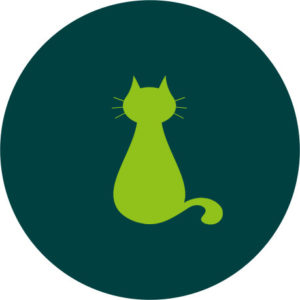
Cat age: 7-10 years
Human equivalent: 44-56 years
The ‘middle age’ of the feline world, mature cats are wiser in the ways of the world yet still agile enough to enjoy it. Although most cats maintain their good health throughout their mature years, this is the stage when you may start to notice subtle changes in your cat’s behaviour, activity level or appetite that could actually be the first signs of illness. Even if your cat seems perfectly normal in themselves, a blood or urine test at this stage may reveal early signs of disease. As a result, more in-depth monitoring is recommended in cats over the age of 7.
Recommended Veterinary Care
| What needs to be done? | How often?* |
| Health check/physical exam | Every 6-12 months |
| Weight check | Every 6-12 months |
| Vaccination | Every 1-3 years according to individual risk assessment |
| Worming | Every 3-12 months as required by lifestyle |
| Flea treatment | Monthly, if you choose to treat, otherwise flea comb monthly |
| Nail trim | Not recommended for outdoor cats |
| Blood pressure check | Optional every 12 months |
| Urine test | Optional every 12 months |
| Blood test | May be recommended based on physical examination or urine test results |
| Pet Insurance | If you have pet insurance, think very carefully before switching policies as previous treatment may exclude future coverage |
*Please note, recommendations may differ between vets and there isn’t necessarily a right or wrong answer, these are just our suggestions based on our desire to keep our cats safe but avoid over-treatment at the same time!
How You Can Help At Home
Understand their need for consistency and predictability
- Mature cats are generally pretty secure in their environment provided there are no significant changes. They are set in their routines and this brings them comfort. You may find that they always go out at a certain time of day, take a certain path around the garden, nap in the same place and expect to be fed at the same time.
- Any break in this routine however, no matter how small and perhaps imperceptible to us humans, can be a source of stress. Even something as simple as adding a new item of furniture or having a friend over for tea may result in undesirable behaviours such as urine marking or scratching. If this occurs, speak with your vet or nurse as there are many ways to help from simple environmental modifications to calming pheromones/supplements.
Understand how they interact with other cats
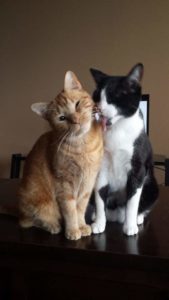
- Most mature cats are very good at getting along with (ie, tolerating) their neighbours and housemates and if you really pay attention, you may notice that your cat ‘time shares’ your garden or even parts of your house with other cats. Conflict is generally avoided at all costs but when some cats feel that another has broken the rules and come too close, a fight will break out.
- If your cat is fighting regularly, consider keeping them indoors at night or discuss an official time sharing schedule if you know the owner of the other cat. If the fighting is between cats of the same household, ask your vet/nurse for help or seek the advice of a feline behaviourist.
- For any cat with outdoor access, a microchip-activated cat flap is recommended. This will both allow them freedom of movement but also safe entry back into the house if they find themselves chased by another cat. Microchip cat flaps keep other cats from entering your house, an extremely distressing situation for your cat.
Pay closer attention to their fluid intake
- Cats are not naturally very good at drinking enough water, and this is particularly true as they age. While it is true that a cat that eats dry food will often be seen at the water bowl, they rarely drink enough to compensate for the dehydrating diet that they are eating. As a result, especially as cats age it is important to increase the amount of water in their food, which may mean gradually phasing out their dry food in exchange for an increased proportion of wet food.
- Keeping cats well-hydrated is not only essential for their comfort and happiness, but the health of their internal organs such as the kidneys as well. Try adding a few spoonfuls of water to their meals or setting up several water stations throughout the house including wide shallow bowls, tall pint glasses or even electric water fountains (although beware, if you spend money on it, there is always a reasonable chance your cat will ignore it and sleep in the box it came in instead…).
Keep them active, both mentally and physically
- Most mature cats still like to play, and are even more prone to put on excess weight so keep up the exercise! Catnip is a great way to get even the most sedentary cat into a more active mood. Puzzle feeders are not only a good way to keep your cat active and slow down their meals but they’re good fun too.
- All cats benefit from an enriched indoor environment including wide, tall and stable scratching posts, catnip toys, feather wand toys, suitable resting places including both enclosed and up high options. For cats without outdoor access, you will have to work a bit harder to provide your cat with the freedom and intellectual stimulation they require. There are many resources online to help with creating a fun indoor environment for all cats including the Indoor Pet Initiative at indoorpet.osu.edu/cats.
Keep them safe
- Be mindful of household hazards and do your best to keep these to a minimum. That means no lilies in the house, full stop! Other common hazards include household cleaners, potpourri, essential oil diffusers, many human foods and all medications.
- Never use topical products on your cat unless specifically recommended by your vet. Medications used on dogs are often not safe for cats, and topical products such as TCP, Germolene, Savlon and tea tree oil can be extremely toxic for cats.
- If your cat wears a collar, make sure it has a safety release.
Feed a high quality, varied diet
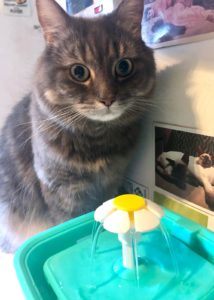
- Remember that cats are strict carnivores – they are built to eat other animals or in other words, meat. Although most cats can tolerate grains and starchy foods to some extent, some cannot. Unless your vet has specifically recommended a particular diet for medical reasons, you are generally safe to feed your cat the highest meat content food you can afford and avoid foods with a lot of grains (carbs) or fillers (NOTE – ‘grain-free’ does not necessarily mean high in meat so check the ingredients list carefully).
- Some food brands offer a ‘senior’ variety, for cats over 7 years old. While these may be appropriate for an overweight, inactive mature cat, they are not necessarily the right choice for an active cat or ones who may be losing weight as they age. If the foods you feed your cat come in a senior variety then feel free to use them but don’t feel like you have to switch to a lower quality food just because it says ‘senior’ on the label. Many of the higher quality foods don’t need a senior version because their diets are more nutritious anyway and therefore suitable for all life stages.
- In general, wet foods are closer to the natural diet of a cat than dry foods and also help prevent dehydration so they are usually a better choice for the majority of your cat’s diet, especially once they hit the mature stage.
- Make sure most of the food you feed your cat says it is ‘complete and balanced’, as feeding too many ‘complementary’ foods can result in dietary imbalances. Just because a food is complete, however, doesn’t mean they should eat the same food every day for years on end. Do their taste buds and their bodies a favour and mix it up from time to time. If your cat has been on the same food for a long time, make the change gradually to avoid upsetting their tummies. Once they get used to the variety, they will be better off for it.
- Meat is the most expensive component of any pet food so unfortunately the best foods for your cat are often the most expensive. Can’t afford top quality cat food 7 days a week? Mix and match, or supplement their diet from time to time with a high quality protein sources such as plain cooked chicken or fish.
- Always make sure your cat has access to fresh water, even if they don’t seem to want to drink it. Cats don’t usually like to eat near where they drink, so separate their food and water dishes.
Monitor their weight
- Mature cats tend to sleep more than when they were younger and as a result, don’t get the exercise that they used to. They also may start to spend more time at home which means more time spent near the food bowl. This could result in a bit of ‘middle age spread’ so watch those portion sizes and try to encourage other means of exercise when possible (puzzle feeders, feather toys, catnip mice, etc).
- Remember, being overweight may be common at this stage but it is not normal and (with the exception of those cats with a bad takeaway habit) we as carers have almost total control over what our cat eats. Weight gain can predispose your cat to serious medical problems like diabetes, heart disease and arthritis later in life.
- Although some cats do OK with food on offer all day, most mature cats require portion control. Figure out how much food your cat should be eating on a daily basis to maintain a healthy weight and put that aside to feed throughout the day – once that’s gone, that’s it until tomorrow! Equally, weight loss is not normal at this age so if you notice this, speak with your vet.
Pay closer attention to their behaviour
- A cat’s mature years are when many very subtle signs of illness start to appear. Slight changes such as increased thirst, decreased activity level, no longer spending much time upstairs or changes in appetite might not seem like much at first but are actually the first signs of illness. If you notice anything unusual about your cat’s behaviour, it’s worth bringing it to the attention of your vet. eat near where they drink, so separate their food and water dishes.
Be mindful of their ageing bodies
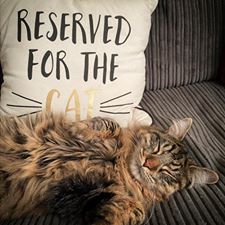
- As your cat enters their mature years, be particularly mindful of their need to stay warm in the winter and cool in the summer. Heated beds and cool pads are a great way to maintain comfort should they choose to use them.
- Some cats, like some lucky humans, are blessed with very good dental genes. Most, however, are not and cats are most likely to show the first signs of declining dental health as they enter the mature stage. Bad teeth are not ‘normal’ for older cats – they often hurt and can complicate the treatment of other health problems so don’t ignore this very important aspect of feline health and happiness.
Good To Know
Cats at this stage will probably still spend a fair amount of time patrolling their territory (inside or outside). Although the frequency of cat fights may start to diminish, they may not want to give in to younger and fitter rivals too easily so keep an eye out for injuries.
Many mature cats still love to hunt. If your cat has outdoor access, be prepared to accept their little ‘gifts’. If this thought terrifies you, keep your cat indoors from dusk till dawn as this is when most hunting occurs.
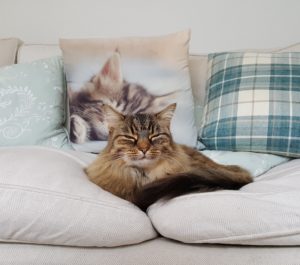
That said, mature cats like to sleep and the older they get, the more time they will probably spend napping. Although a slight decrease in activity may be normal at this age, keep a close eye on their sleeping habits and notify your vet if you notice any changes as this can be an early sign of illness.
Mature cats can often be found grooming themselves. Grooming is a healthy behaviour and usually indicates that the cat is relaxed, happy and feeling well. A lack of grooming however, or excessive grooming resulting in hair loss or trauma to the skin, should be brought to the attention of your vet. A cat with mats along their back, for example, may have dental or back pain that prevents them from grooming regularly.
It is normal and essential for cats to scratch things with their claws in order to keep their nails at a healthy length and as a sign of territory marking, much as they would learn to do in the wild. If you don’t want that ‘thing’ to be your sofa, provide a wide variety of scratching posts of different materials and sizes for your cat to choose from. Maintaining their claws becomes harder as they age so keep an eye out for problems and give them a little trim as needed.
It is normal for cats to prefer a varied diet as this natural instinct helps protect them from dietary imbalances. They may happily eat one type of food one day, then turn their nose up at it the next. Don’t get angry or give up, simply put the rest of that variety in the cupboard and try again in a few weeks, chances are they’ll try it again later. If your cat becomes particularly picky with their food however, especially if they regularly vomit or suffer from diarrhoea/constipation, speak with your vet as this is likely a sign of illness.
This guide is based on the AAFP-AAHA Feline Life Stage Guidelines publication, as well as recommendations made by the ISFM CatCareforLife and iCatCare websites – please visit these highly informative websites for additional information.

